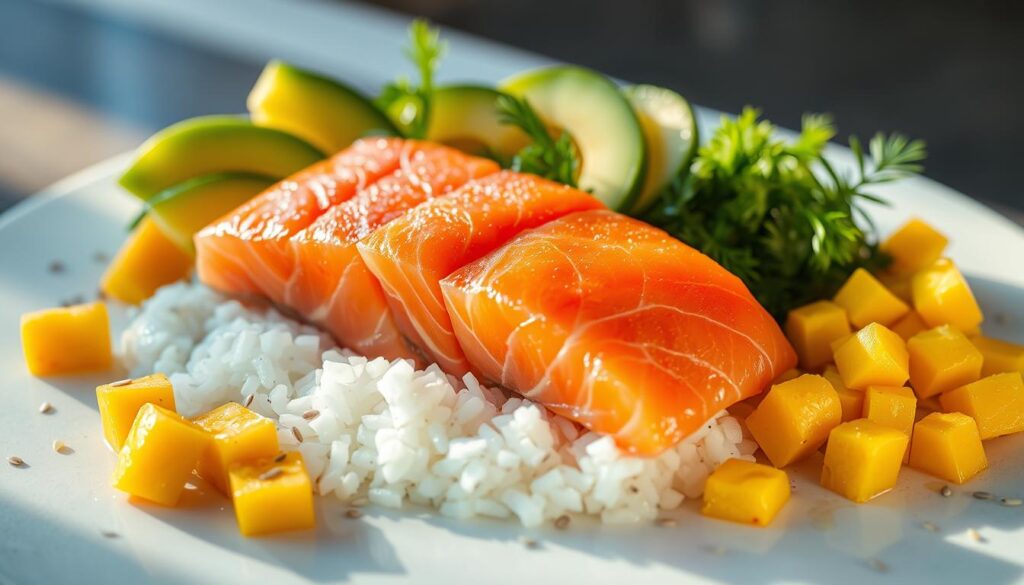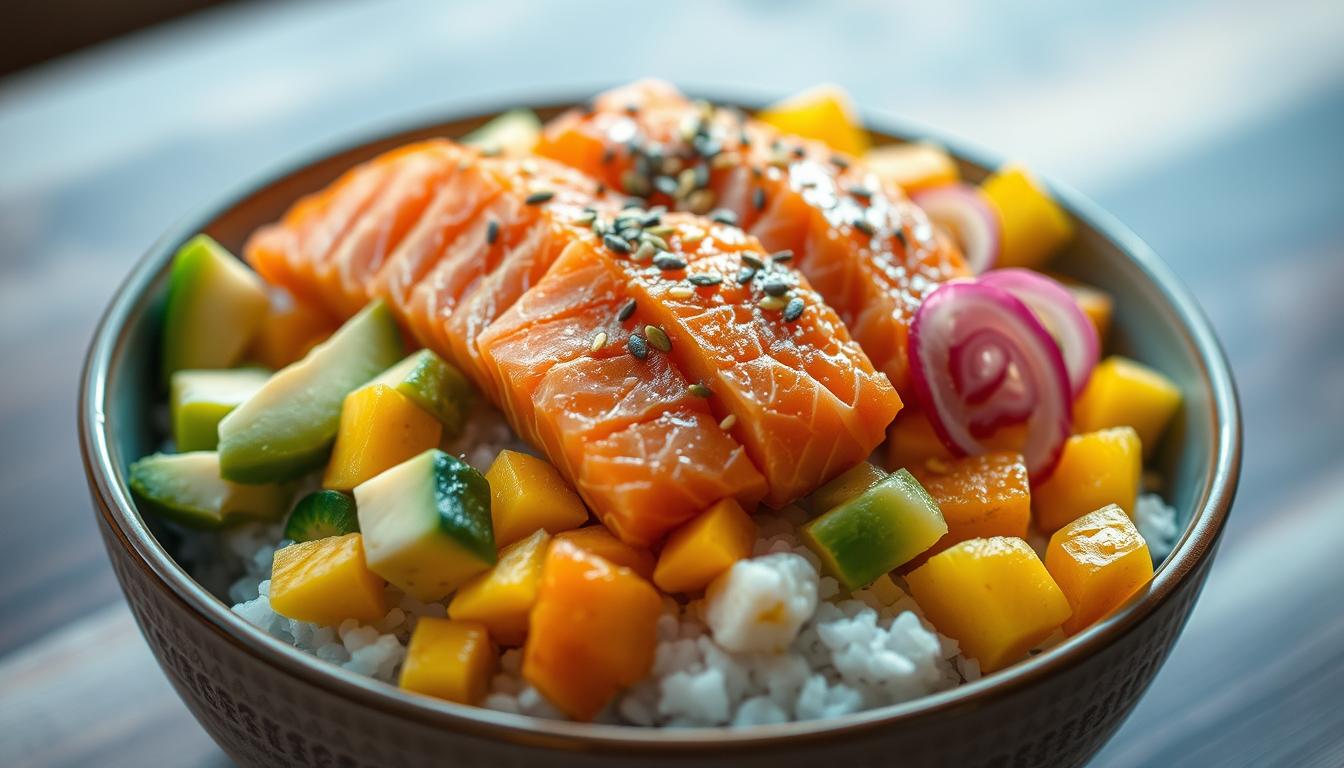How to Make the Perfect Salmon Poke Bowl at Home
How to Make the Perfect Salmon Poke Bowl at Home
Ever crave a fresh, restaurant-quality meal without the hassle or cost? Imagine biting into tender, marinated fish paired with crisp veggies and nutty sesame—all in under 30 minutes. This dish brings Hawaii’s vibrant flavors straight to your kitchen.
Originating from Hawaiian cuisine, this meal balances umami-rich sauces with crunchy toppings. It’s customizable, packed with lean protein, and costs less than $3 per serving. Whether you’re meal prepping or hosting friends, it’s a crowd-pleaser.
With sushi-grade fish and fresh ingredients like avocado and ginger, every bite delivers texture and flavor. Ready to ditch takeout? Let’s dive in.
Key Takeaways
- Restaurant-quality results in just 30 minutes
- Uses affordable, fresh ingredients for under $3 per serving
- Customizable with veggies, fruits, and sauces
- High in protein and healthy fats
- Perfect for meal prep or quick dinners
Why You’ll Love This Salmon Poke Bowl Recipe
Skip the takeout line—this dish delivers bold flavors fast. With restaurant-quality results and zero fuss, it’s a game-changer for busy weeknights or impromptu gatherings.

Fresh, Flavorful Science
Marinating sushi-grade fish in soy sauce and sesame oil does more than add taste. The enzymes break down proteins, creating a buttery texture. Plus, fresh ingredients like ginger and lime brighten every bite.
Make It Your Own
Swap grains, veggies, or sauces to match your cravings. Try:
- Creamy avocado with tangy pickled cucumbers
- Crunchy cabbage or spicy jalapeños
- Quinoa instead of rice for extra protein
At under $3 per serving, this meal saves 80% versus dining out. Your wallet—and taste buds—will thank you.
Essential Ingredients for a Salmon Poke Bowl
Quality components transform a simple meal into a culinary masterpiece. Each element plays a vital role—from the buttery fish to the tangy sauce and crisp veggies. Here’s what you’ll need.

Sushi-Grade Fish: The Star
Opt for sushi-grade salmon, frozen to eliminate parasites. Wild Alaskan varieties offer a buttery texture, while farmed types taste richer. Always check for bright color and firm flesh.
Poke Sauce Staples
The sauce blends soy sauce (or Tamari for gluten-free), sesame oil, and rice vinegar. Kikkoman vinegar balances umami with acidity. A dash of honey adds subtle sweetness.
Crunchy Veggie Trio
Layer textures with:
- Avocado (creamy)
- Cucumber (crisp)
- Red cabbage (crunchy)
Add diced bell peppers or green onions for extra color and bite.
How to Prepare the Salmon Poke
Mastering the art of preparing fresh fish starts with precision and flavor balance. Two steps make or break this dish: perfect cutting and a well-crafted poke sauce.
Knife Skills Matter
Slice sashimi-grade fillets into ¾-inch cubes. This size retains texture without overwhelming bites. Use a sharp knife and a board reserved for raw fish to avoid cross-contamination.
Timing the Marination
Marinating unlocks depth but shouldn’t overpower. Aim for 15 minutes minimum—up to 2 hours max. Beyond this, acidity breaks down the flesh too much.
For the sauce, blend:
- 4 parts soy sauce (umami base)
- 1 part sesame oil (richness)
- 1 part rice vinegar (brightness)
Adjust with ginger or citrus zest for extra zing. Drizzle sparingly to let the fish shine.
Quick-Pickled Cucumbers for Extra Crunch
Transform ordinary cucumbers into a vibrant, crunchy delight. These quick-pickled slices add a tangy punch and crisp texture to your dish—ready in just 10 minutes.
The Perfect Brine Formula
Mix 1 part rice vinegar and 1 part water with 2 parts sugar and 1 part salt. This balance of sweet and acidic ensures bright flavor without overpowering the cucumber.
Crisp Results Every Time
Use Persian cucumbers for seedless crunch. Slice them thinly with a mandoline for even pickling. For faster chilling, pop the jar in the freezer for 5 minutes before serving.
Flavor variations:
- Add ginger slices or chili flakes for heat
- Toss in sesame seeds for nutty depth
Store leftovers in the fridge for up to 5 days. Reuse the brine for salad dressings or marinades—zero waste, maximum flavor.
Assembling Your Salmon Poke Bowl
Plating transforms your meal into a colorful masterpiece. Follow these steps to create a balanced, Instagram-worthy dish that’s as delicious as it looks.
Layering Rice and Veggies for the Base
Start with a sushi rice base. Press it gently into the bowl to create a stable foundation. This prevents toppings from sinking.
Add veggies like purple cabbage or carrots for vibrant color contrast. Cluster them in sections for visual appeal.
Arranging Salmon and Toppings for Visual Appeal
Place marinated fish cubes in a radial pattern at the top. Surround them with avocado slices and edamame for texture contrast.
Use a ring mold for neat layers. Finish with a drizzle of spicy aioli and toasted sesame seeds.
Creative Variations to Try
Customization is key—explore these flavorful swaps to suit your taste. Whether you’re avoiding allergens or craving new textures, these ideas keep your meals exciting.
Protein Swaps for Every Preference
Swap raw fish for seared ahi tuna or cooked shrimp. Tofu works for plant-based diets—marinate it in soy sauce for umami depth.
Prefer warmth? Try air-fried salmon cubes or teriyaki chicken. Each protein brings unique flavors to the combination.
Gluten-Free and Dairy-Free Tweaks
Use gluten-free coconut aminos instead of soy sauce. Vegan mayo adds creaminess without dairy.
Skip furikake if avoiding gluten—toasted sesame seeds offer crunch safely.
Grains That Go Beyond Rice
Quinoa’s nutty flavor pairs well with spicy toppings. For chewiness, opt for brown rice or cauliflower rice for low-carb meals.
- Fusion twists: Top with mango salsa or kimchi for tangy heat.
- Meal prep tip: Store grains separately to avoid sogginess.
Storage and Meal Prep Tips
Keep your homemade creations fresh and flavorful with smart storage tricks. Proper handling ensures ingredients retain texture and taste, whether you’re prepping ahead or saving leftovers.
Refrigeration Timelines
Store components separately to maximize freshness. Here’s how long each lasts in the fridge:
- Fish: 24 hours (marinated raw varieties spoil faster)
- Veggies (cabbage, cucumber): Up to 4 days in airtight containers
- Rice: 3 days—cool slightly before storing to prevent sogginess
Ingredient-Specific Storage Hacks
Use glass containers with dividers to control moisture. For avocado, leave the pit in and brush with lemon juice to delay browning.
Meal prep pro tip: Freeze cooked grains like quinoa, but avoid freezing marinated raw fish—it alters texture.
Defrost frozen fish safely by transferring it to the fridge 24 hours before use.
Conclusion
Bring vibrant island flavors to your table in minutes. This homemade dish saves money while delivering healthy, balanced nutrition—no restaurant markup required.
Make it your own with the easy swaps listed earlier. Try spicy mayo, mango salsa, or seared tuna. Always use sushi-grade fish and marinate safely.
Pro tip: Double-batch pickled cucumbers for future salmon poke bowl cravings. They add crunch for days.
Loved this recipe? Rate it or tag #FreshPokeCreations to inspire others!
FAQ
Can I use frozen fish for this dish?
What’s the best substitute for soy sauce?
How long should I marinate the fish?
Can I make this ahead for meal prep?
What other veggies can I add?
Is brown rice a good alternative to sushi rice?
How spicy can I make the sauce?

